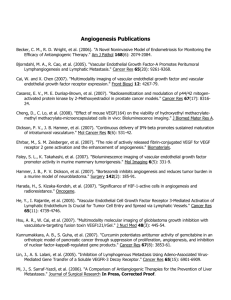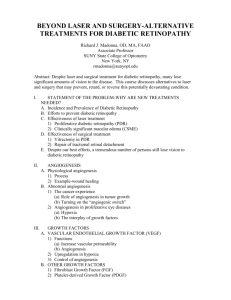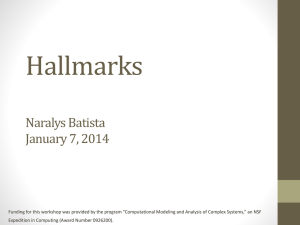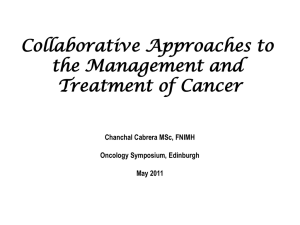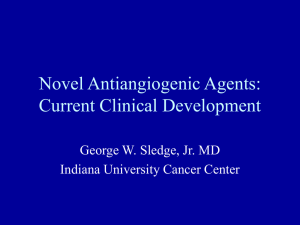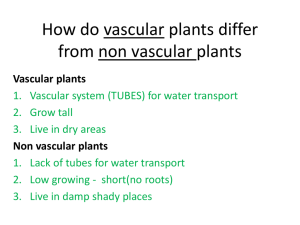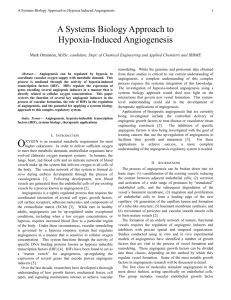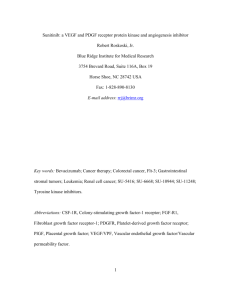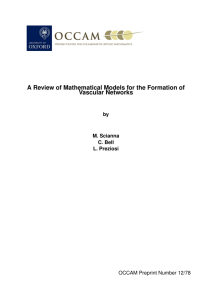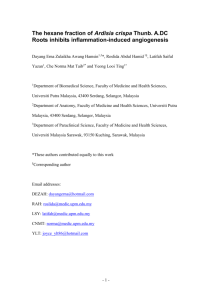recent insights in the regulation of angiogenesis and its - uni
advertisement
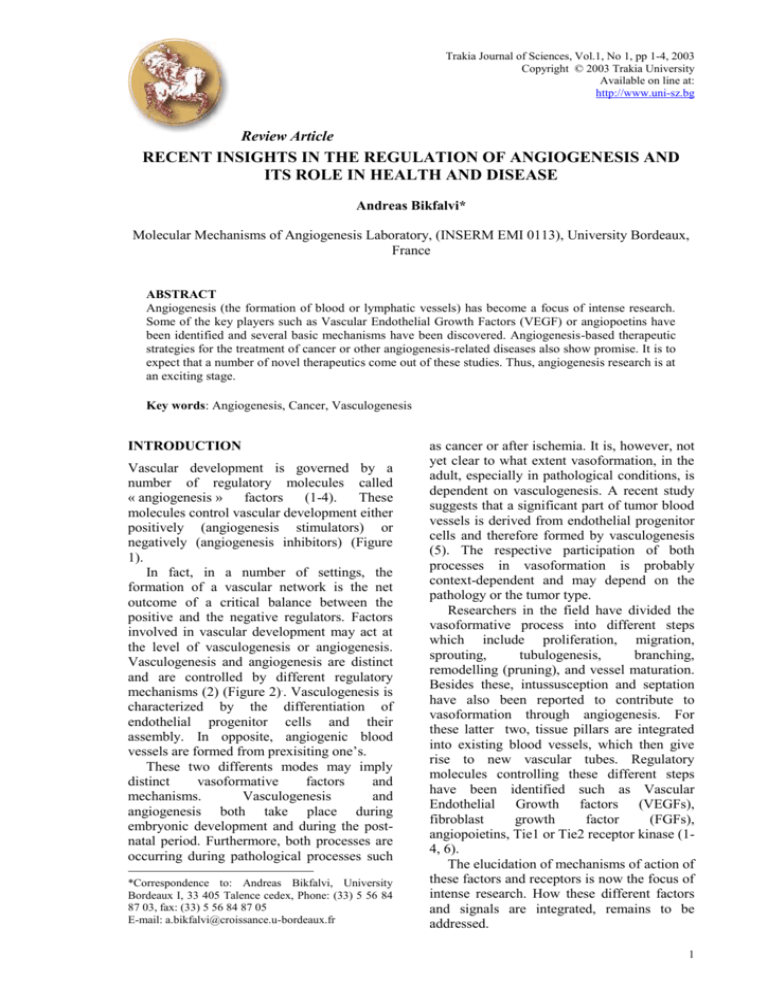
Trakia Journal of Sciences, Vol.1, No 1, pp 1-4, 2003 Copyright © 2003 Trakia University Available on line at: http://www.uni-sz.bg Review Article RECENT INSIGHTS IN THE REGULATION OF ANGIOGENESIS AND ITS ROLE IN HEALTH AND DISEASE Andreas Bikfalvi* Molecular Mechanisms of Angiogenesis Laboratory, (INSERM EMI 0113), University Bordeaux, France ABSTRACT Angiogenesis (the formation of blood or lymphatic vessels) has become a focus of intense research. Some of the key players such as Vascular Endothelial Growth Factors (VEGF) or angiopoetins have been identified and several basic mechanisms have been discovered. Angiogenesis-based therapeutic strategies for the treatment of cancer or other angiogenesis-related diseases also show promise. It is to expect that a number of novel therapeutics come out of these studies. Thus, angiogenesis research is at an exciting stage. Key words: Angiogenesis, Cancer, Vasculogenesis INTRODUCTION Vascular development is governed by a number of regulatory molecules called « angiogenesis » factors (1-4). These molecules control vascular development either positively (angiogenesis stimulators) or negatively (angiogenesis inhibitors) (Figure 1). In fact, in a number of settings, the formation of a vascular network is the net outcome of a critical balance between the positive and the negative regulators. Factors involved in vascular development may act at the level of vasculogenesis or angiogenesis. Vasculogenesis and angiogenesis are distinct and are controlled by different regulatory mechanisms (2) (Figure 2).. Vasculogenesis is characterized by the differentiation of endothelial progenitor cells and their assembly. In opposite, angiogenic blood vessels are formed from prexisiting one’s. These two differents modes may imply distinct vasoformative factors and mechanisms. Vasculogenesis and angiogenesis both take place during embryonic development and during the postnatal period. Furthermore, both processes are occurring during pathological processes such *Correspondence to: Andreas Bikfalvi, University Bordeaux I, 33 405 Talence cedex, Phone: (33) 5 56 84 87 03, fax: (33) 5 56 84 87 05 E-mail: a.bikfalvi@croissance.u-bordeaux.fr as cancer or after ischemia. It is, however, not yet clear to what extent vasoformation, in the adult, especially in pathological conditions, is dependent on vasculogenesis. A recent study suggests that a significant part of tumor blood vessels is derived from endothelial progenitor cells and therefore formed by vasculogenesis (5). The respective participation of both processes in vasoformation is probably context-dependent and may depend on the pathology or the tumor type. Researchers in the field have divided the vasoformative process into different steps which include proliferation, migration, sprouting, tubulogenesis, branching, remodelling (pruning), and vessel maturation. Besides these, intussusception and septation have also been reported to contribute to vasoformation through angiogenesis. For these latter two, tissue pillars are integrated into existing blood vessels, which then give rise to new vascular tubes. Regulatory molecules controlling these different steps have been identified such as Vascular Endothelial Growth factors (VEGFs), fibroblast growth factor (FGFs), angiopoietins, Tie1 or Tie2 receptor kinase (14, 6). The elucidation of mechanisms of action of these factors and receptors is now the focus of intense research. How these different factors and signals are integrated, remains to be addressed. 1 A. BIKFALVI Figure 1. The angiogenic balance. Angiogenesis is controlled by positive and negative regulators. The net outcome of the effect on angiogenesis is due to the respective concentrations/activities of that act on the vasculature. These regulators are modulated by hypoxia, oncogenes or growth factors which all either increase the positive regulators, decrease the negative regulators or do both. Figure 2. Paracrine relationships in angiogenesis. An embryonic or adult healthy or pathological tissue (i.e; tumor) produces higher relative amounts of positive regulators than negative regulators to stimulate vascular development. This will either induce the formation of vascular tubes by sprouting (angiogenesis) or by recruitment of endothelial cell progenitors (EPC) that differentiate in situ into vascular endothelial cells and incorporate into vascular tubes (vasculogenesis). Hematopoietic cells (HC) from the bone marrow are also recruited to reinforce this effect. Another recent development in the angiogenesis field is the relationship of angiogenesis and neurogenesis (2). Vascular and neural development share similarities and are regulated by survival and differentiation factors. It has been recently recognized that neuropillin-1 (NRP-1) and neuropillin-2 (NRP-2) that are receptors for the semaphorins/collapsins are also coreceptors for VEGF family members (2,7). 2 Furthermore, Ephrins and their respective Eph receptors that provide guidance cues for axons, also regulate arterio-venous differentiation and vessel assembly (2,8). Lymphatic vessels seems two require, to some extent, their own set of regulators and mechanisms. Lymphangiogenesis is controlled by the prox gene, VEGF-C, VEGFD, VEGF receptor-3 (VEGFR3) and fibroblast growth factors but not by VEGF-A or VEGF- Trakia Journal of Sciences, Vol.1, No 1, 2003 A. BIKFALVI B (2, 9-10). It has been recently demonstrated that metastatic spread in transgenic mice can be induced by VEGF-C expression (10). Are vasculogenesis and angiogenesis also basic principles for the formation of lymphatic blood vessels ? It is possible that lymphatic endothelial cell precursors exist, similar to the endothelial cell precursors described for blood vessels, that participate to lymphatic vasculogenesis (11). Another issue of angiogenesis factors is the question of their specificity. It has been believed over the past 10 years that the master regulators of vasoformation are specific for the vasculature. This is perhaps less true as initially thought. As an example, VEGFs have been claimed to regulate specifically the vascular development but not to interact with other cell types or tissues. This claim was mainly supported by gene knock-out studies in mice of VEGF-A or its tyrosine kinasereceptors, in which significant vascular phenotypes were revealed (12). However, recent evidence indicate that VEGFs are important for other functions as well such as neural stem cell survival or hematopoiesis (13,14). Thus, VEGFs are becoming broad range-morphogens and may resemble in this respect FGF family members. A large panel of endogenous regulatory molecules, fragments or designer drugs are under pre-clinical or clinical evaluation for angiogenesis or antiangiogenesis therapy (1,2, 15). Among these, VEGF kinases inhibitors are very promising agents. It is, however, important, especially for anti-angiogenesis strategies, to optimise these therapies. An interesting approach for the optimisation of antiangiogenesis therapy is certainly its association with low dose-chemotherapy (15,16,17). Another approach is the combination of several anti-angiogenesis drugs. For example, the association of endostatin, angiostatin and TNP470 is more effective than single drugs alone (18). However, these combinations should be designed rationally and molecules with complementary mechanisms of actions should be associated. For example, lymphangiogenesis inhibitors may be associated with blood vessel inhibitors as this combination would inhibit the primary tumor and the metastatic spread through the lymphatics. The development of more specific lymphangiogenesis inhibitors such as indolinones, that inhibit the interaction of VEGF-C and D with VEGFR3, is, in this respect, important (19). An interesting venue for further developments is also the identification and optimisation of molecules already in clinical use such as HIV protease inhibitors that are potent antiangiogenesis molecules and promote the regression of Kaposi sarcoma lesions (20). REFERENCES 1. Hagedorn, M., and Bikfalvi, A., Target molecule for anti-angiogenesis therapy : from basic research to clinical trials. Critical Reviews in Oncology Hematology, 34 : 89110, 2000. 2. Bikfalvi, A., Bicknell R., Recent advances in angiogenesis, anti-angiogenesis and vascular targeting. Trends Pharmacol Sci ; 23: 576-82, 2002. 3. Ferrara, N., VEGF and the quest for tumour angiogenesis factors. Nat Rev Cancer; 2 : 795803, 2002. 4. Javerzat, S., Auguste, P., Bikfalvi, A., The role of fibroblast growth factors in vascular development. Trends Mol. Med., 8 : 483-489, 2002. 5. Lyden, D., Hattori, K., Dias, S. et al., Impaired recruitment of bone-marrow-derived endothelial and haematopoietic precursor cells blocks tumour angiogenesis and growth. Nat Med, 7 : 1194-201, 2001. 6. Yancopoulos, G.D., Davis, S., Gale, N.W., Rudge, J.S., Wiegand, S.J., Holash, J., Vascular-specific growth factors and blood vessel formation. Nature, 407 : 242-248, 2000. 7. Miao, H.Q., and Klagsbrun, M., Neuropilin is a mediator of angiogenesis. Cancer Metastasis Rev., 19 : 29-37, 2000. 8. Adams, R.H., and Klein R. , Eph receptors and ephrin ligands. essential mediators of vascular development. Trends Cardiovasc Med, 10 : 183-8, 2000. 9. Alitalo, K., and Carmeliet, P., Molecular mechanisms of lymphangiogenesis in health and disease. Cancer Cell, 1 : 219-27, 2002. 10. Stacker, S.A., Achen ,M.G;, Jussila, L., Baldwin, M.E., and Alitalo, K., Lymphangiogenesis and cancer metastasis. Nat. Rev. Cancer , 2 : 573-83, 2002. 11. Salven, P., Mustjoki, S., Alitalo, R., Alitalo, K., Rafii, S., VEGFR-3 and CD133 identify a population of CD34+ lymphatic/vascular endothelial precursor cells. Blood, 101 : 168-172, 2003. 12. Carmeliet, P., Ferreira, V., Breier, G., Pollefeyt, S., Kieckens, L., Gertsenstein, M., Fahrig, M., Vandenhoeck, A., Harpal, K., Eberhardt, C., Declercq, C., Pawling, J., Moons, L., Collen, D., Risau, W., Nagy, A., Abnormal blood vessel development and Trakia Journal of Sciences, Vol.1, No 1, 2003 3 A. BIKFALVI lethality in embryos lacking a single VEGF allele. Nature, 380 : 435-439, 1996. 13. Jin, K., Zhu, Y., Sun, Y., Mao, X.O., Xie, L., and Greenberg, D.A., Vascular endothelial growth factor (VEGF) stimulates neurogenesis in vitro and in vivo. Proc Natl Acad Sci U.S.A. , 99 : 11946-11950, 2002. 14 Gerber, H.P., and Ferrara, N., The role of VEGF in normal and neoplastic hematopoiesis. J. Mol. Med., 81 : 20-31, 2003. 15. Kerbel, R., and Folkman, J., Clinical translation of angiogenesis inhibitors. Nat. Rev.Cancer, 2 : 727-39, 2002. 16. Klement, G., Baruchel, S., Rak, J., et al. Continuous low-dose therapy with vinblastine and VEGF receptor-2 antibody induces sustained tumor regression without overt toxicity. J. Clin. Invest., 105 : R15-24, 2000. 17. Bello, L., Carrabia, G., Giussani, C., Lucini, V., Cerutti, F., Scaglione, F., Landre, J., Pluderi, M., Tomei, G., Villani, R., Carroll, R., Black, P., and Bikfalvi, A., Low-dose 4 chemotherapy combined with antiangiogenic drug reduces human glioma growth in vivo. Cancer Res., 61: 7501-7506, 2001. 18. Bergers, G., Javaherian, K., Lo, K.M., et al. Effects of angiogenesis inhibitors on multistage carcinogenesis in mice. Science, 284 : 808-12, 1999. 19. Kirkin, V., Mazitschek, R., Krishnan, J., Steffen, A., Waltenberger, J., Pepper ,M.S., Giannis, A., and Sleeman, J.P., Characterization of indolinones which preferentially inhibit VEGF-C- and VEGF-Dinduced activation of VEGFR-3 rather than VEGFR-2. Eur. J. Biochem. , 268 : 55305540, 2002. 20. Barillari, G., Ensoli, B., Angiogenic effects of extracellular human immunodeficiency virus type 1 Tat protein and its role in the pathogenesis of AIDSassociated Kaposi's sarcoma. Clin. Microbiol. Rev., 15 : 310-326, 2002. Trakia Journal of Sciences, Vol.1, No 1, 2003
